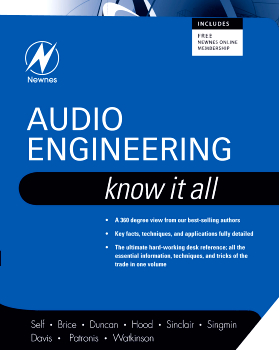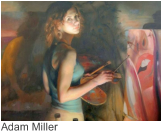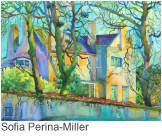Berikut ini, saya coba berbagi salah satu buku yang berkaitan dengan audio. (link unduhan di bawah sendiri)
Author(s) : Self & Duncan & Sinclair & Brice & Hood & Singmin & Davis & Patronis & Watkinson
Release Date: 29 Sep 2008
Imprint: Newnes
ISBN: 9781856175265
Review:
Authors:
Douglas Self, etc.
Affiliations and Expertise
Douglas Self has a worldwide reputation as a leading authority on audio amplifier design, but it is perhaps less well known that he has devoted a good deal of study to small-signal circuitry, including many years as the chief design engineer at one of the major mixing console manufacturers, where his achievements included winning a Design Council Award. His rigorous, skeptical, and thoroughly practical approach to design has been applied to the small signal area as well, and some of the results to be found in this book. Senior designer of high-end audio amplifiers and contributor to Electronics World magazine, Douglas has worked with many top audio names, including Cambridge Audio, TAG-McLaren Audio, and Soundcraft Electronics.View additional works by Douglas Self
Table of contents:
Part I Fundamentals of Sound
Chapter 1 Audio Principles
1.1 The physics of sound
1.2 Wavelength
1.3 Periodic and aperiodic signals
1.4 Sound and the ear
1.5 The cochlea
1.6 Mental processes
1.7 Level and loudness
1.8 Frequency discrimination
1.9 Frequency response and linearity
1.10 The sine wave
1.11 Root mean square measurements
1.12 The deciBel
1.13 Audio level metering
References
Chapter 2. Measurement
2.1 Concepts Underlying the Decibel and Its Use in Sound Systems
2.2 Measuring Electrical Power
2.3 Expressing Power as an Audio Level
2.4 Conventional Practice
2.5 The Decibel in Acoustics—LP, LW, and LI
2.6 Acoustic Intensity Level (LI), Acoustic Power Level (LW), and Acoustic Pressure Level (LP)
2.7 Inverse Square Law
2.8 Directivity Factor
2.9 Ohm’s Law
2.10 A Decibel Is a Decibel Is a Decibel
2.11 Older References
2.12 The Equivalent Level (LEQ) in Noise Measurements
2.13 Combining Decibels
2.14 Combining Voltage
2.15 Using the Log Charts
2.16 Finding the Logarithm of a Number to Any Base
2.17 Semitone Intervals
2.18 System Gain Changes
2.19 The VU and the VI Instrument
2.20 Calculating the Number of Decades in a Frequency Span
2.21 Deflection of the Eardrum at Various Sound Levels
2.22 The Phon
2.23 The Tempered Scale
2.24 Measuring Distortion
2.25 The Acoustical Meaning of Harmonic Distortion
2.26 Playback Systems in Studios
2.27 Decibels and Percentages
2.28 Summary
Bibliography
Chapter 3 Acoustic Environment
3.1 The Acoustic Environment
3.2 Inverse Square Law
3.3 Atmospheric Absorption
3.4 Velocity of Sound
3.5 Temperature-Dependent Velocity
3.6 The Effect of Altitude on the Velocity of Sound in Air
3.7 Typical Wavelengths
3.8 Doppler Effect
3.9 Reflection and Refraction
3.10 Effect of a Space Heater on Flutter Echo
3.11 Absorption
3.12 Classifying Sound Fields
3.13 The Acoustic Environment Indoors
3.14 Conclusion
II. Audio Electronics
Chapter 4 Components
4.1 Building Block Components
Chapter 5 Power supply design
5.1 High Power Systems
5.2. Solid State Rectifiers
5.3. Music Power
5.4. Influence of Signal Type on Power Supply Design
5.5. High Current Power Supply Systems
5.6. Half-wave and Full-wave Rectification
5.7. DC Supply Line Ripple Rejection
5.8. Voltage Regulator Systems
5.9. Series Regulator Layouts
5.10. Over-current Protection
5.11. Integrated Circuit (Three Terminal) Voltage Regulator ICs
5.12. Typical Contemporary Commercial Practice
5.13. Battery Supplies
5.14. Switch-mode Power Supplies
III Preamplifiers and Amplifiers
Chapter 6 Introduction to Audio Amplification
CHAPTER 7 Preamplifiers and input signals
7.1 REQUIREMENTS
7.2 SIGNAL VOLTAGE AND IMPEDANCE LEVELS
7.3 GRAMOPHONE PICK-UP INPUTS
7.4 INPUT CIRCUITRY
7.5 MOVING COIL PU HEAD AMPLIFIER DESIGN
7.6 CIRCUIT ARRANGEMENTS
7.7 INPUT CONNECTIONS
7.8 INPUT SWITCHING
7.9 Voltage amplifiers and controls
7.10 PREAMPLIFIER STAGES
7.11 LINEARITY
7.12 NOISE LEVELS
7.13 OUTPUT VOLTAGE CHARACTERISTICS
7.14 VOLTAGE AMPLIFIER DESIGN
7.15 CONSTANT-CURRENT SOURCES AND 'CURRENT MIRRORS'
7.16 PERFORMANCE STANDARDS
7.17 AUDIBILITY OF DISTORTION
7.18 GENERAL DESIGN CONSIDERATIONS
7.19 CONTROLS
Chapter 8 Interfacing and processing
8.1 The Input
8.2 RF filtration
8.3 The balanced input
8.4 Sub-sonic protection and high-pass filtering
8.5 Damageprotection
8.6 What are process functions?
8.7 Computer control
Chapter 9 Audio amplifiers
9.1. Junction Transistors
9.2. Control of Operating Bias
9.3. Stage Gain
9.4. Basic Junction Transistor Circuit Configurations
9.5. Emitter-follower Systems
9.6. Thermal Dissipation Limits
9.6. Junction Field Effect Transistors (JFETs)
9.7. Insulated Gate FETs (MOSFETs)
9.8. Power BJTs vs. Power MOSFETs as Amplifier Output Devices
9.9. U and D MOSFETs
9.10. Useful Circuit Components
9.11. Circuit Oddments
9.12. Slew Rate Limiting
Chapter 10 Audio amplifier performance
10.1 A brief history of amplifiers
10.2 Amplifier architectures
10.3 The three-stage architecture
10.4 Power amplifier classes
10.5 AC- and DC-coupled amplifiers
10.6 Negative feedback in power amplifiers
References
Chapter 11. Valve (tube-based) amplifiers
11.1 Valves or Vacuum Tubes
11.2 Solid State Devices
11.3 VALVE AUDIO AMPLIFIER LAYOUTS
11.4 Single-ended vs. Push–pull Operation
11.5 Phase Splitters
11.6 Output Stages
11.7 Output (Load-matching) Transformer
11.8 Effect of Output Load Impedance
11.9 Available Output Power
Chapter 12 Negative feedback
12.1 Amplifier stability and NFB
12.2 Maximising the NFB
12.3 Maximising linearity before feedback
12.4 References
Chapter 13 Noise and grounding
13.1. Audio amplifier PCB design
13.2. Amplifier grounding
13.3. Ground loops: how they work and how to deal with them
13.4 Class I and Class II
13.5 Mechanical layout and design considerations
Part IV Digital Audio
Chapter 14 Digital audio fundamentals
14.1 Audio as data
14.2 What is an audio signal?
14.3 Why binary?
14.4 Why digital?
14.5 Some digital audio processes outlined
14.6 Time compression and expansion
14.7 Error correction and concealment
14.8 Channel coding
14.9 Audio compression
14.10 Disk-based recording
14.11 Rotary-head digital recorders
14.12 Digital audio broadcasting
14.13 Networks
Chapter 15 Representation of Audio Signals
15.1 Introduction
15.2 Analogue and Digital
15.3 Elementary Logical Processes
15.4 The Significance of Bits and Bobs
15.5 Transmitting Digital Signals
15.6 The Analogue Audio Waveform
15.7 Arithmetic
15.8 Digital Filtering
15.9 Other Binary Operations
15.10 Sampling and Quantising
15.12 Transform and Masking Coders
15.13 Bibliography
15.14 Other titles of interest
Chapter 16.Compact disc
16.1 PROBLEMS WITH DIGITAL ENCODING
16.2 THE RECORD-REPLAY SYSTEM
16.3 THE REPLAY SYSTEM
16.4 ERROR CORRECTION
Chapter 17 Digital audio recording basics
17.1 Types of Media
17.2 Recording Media Compared
17.3 Some Digital Audio Processes Outlined
17.4 Hard Disc Recorders
17.5 The PCM Adaptor
17.6 An Open Reel Digital Recorder
17.7 Rotary Head Digital Recorders
17.8 Digital Compact Cassette
17.9 Editing Digital Audio Tape
Chapter 18 Digital audio interfaces
18.1 Digital audio interfaces
18.2 MADI (AES10–1991) serial multi-channel audio digital interface
Chapter 19 Data compression
19.1 Lossless compression
19.2 Intermediate compression systems
19.3 Psychoacoustic masking systems
19.4 MPEG layer 1 compression (PASC)
19.5 MPEG layer 2 audio coding (MUSICAM)
19.6 MPEG layer 3
19.7 MPEG-4
19.8 Digital audio production
Chapter 20 Digital audio production
20.1 Digital audio workstations (DAWs)
20.2 Audio data files
20.3 Sound cards
20.4 PCI bus versus ISA bus
20.5 Disks and other peripheral hardware
20.6 Hard drive interface standards
20.7 Digital noise generation – chain-code generators
20.8 Notes
Chapter 21 Other Digital Audio Devices
21.1 Video Recorders
21.2 HDCD
21.3 CD Writers
21.4 MPEG Systems
21.5 MP3
21.6 Transcribing a Recording by Computer
21.7 WAV Onwards
21.8 DAM CD
21.9 DVD and Audio
V. Microphone and Loudspeaker Technology
Chapter 22 Microphone technology
22.1 Microphone Sensitivity
22.2 Microphone Selection
22.3 Nature of Response and Directional Characteristics
22.3 Wireless Microphones
22.4 Microphone Connectors, Cables, and Phantom Power
22.5 Measurement Microphones
22.6 Bibliography
29.17. References
Chapter 23 Loudspeakers
23.1 Radiation of Sound
23.2 Characteristic Impedance
23.3 Radiation Impedance
23.4 Radiation from a Piston
23.5 Directivity
23.6. Sound Pressure Produced at Distance r
23.6. Electrical Analogue
23.7. Diaphragm/Suspension Assembly
23.8. Diaphragm Size
23.9. Diaphragm Profile
23.10. Straight-Sided Cones
23.11 Material
23.12 Soft Domes
23.13 Suspensions
23.14 Voice Coil
23.15 Moving Coil Loudspeaker
23.16 Motional Impedance
Chapter 24 Loudspeaker enclosures
24.1 Loudspeakers
24.2 The interrelation of components
Chapter 25 Headphones
25.1 A Brief History
25.2 Pros and Cons of Headphone Listening
25.3 Headphone Types
25.4 Basic Headphone Types
25.5 Measuring Headphones
25.6 The Future
Part VI. Sound Reproduction Systems
Chapter 26 Tape Recording
26.1 Introduction
26.2 Magnetic theory
26.3 The physics of magnetic recording
26.4 Bias
26.5 Equalisation
26.6 Tape speed
26.7 Speed stability
26.8 Recording formats – analogue machines
Chapter 27 Recording consoles
27.1 Introduction
27.2 Standard levels and level meters
27.3 Standard operating levels and line-up tones
27.4 Digital line-up
27.5 Sound mixer architecture and circuit blocks
27.6 Audio mixer circuitry
27.7 Mixer automation
27.8 Digital consoles
27.9 Note
Chapter 28 Video synchronization
28.1. Introduction
28.2. Persistence of vision
28.3. Cathode ray tube and raster scanning
28.4. Television signal
28.5. Colour perception
28.6. Colour television
28.7. Analogue video interfaces
28.8. Digital video
28.9. Embedded digital audio in the digital video interface
28.10. Timecode
28.11. Notes
Chapter 29 Room acoustics
29.1 Introduction
29.2 Noise Control
29.3 Studio and Control Room Acoustics
Reference
Part VII Audio Test and Measurement
CHAPTER 30 Fundamentals and instruments
30.1 INSTRUMENT TYPES
30.2 SIGNAL GENERATORS
30.3 ALTERNATIVE WAVEFORM TYPES
30.4 DISTORTION MEASUREMENT
Ini link unduhan-nya.












Tidak ada komentar:
Posting Komentar
Pengunjung yang baik, akan meninggalkan jejak yang baik pula. Silahkan berkomentar dan memberikan masukan untuk kemajuan blog ini.
Terimakasih sudah berkunjung.